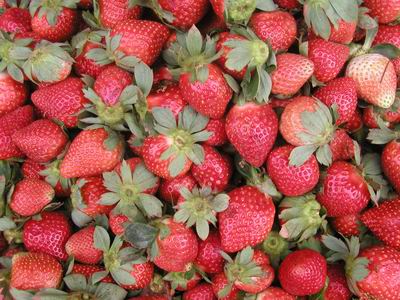
Anyone with allergies can tell you that they suck pretty hard. Particularly in Japan, the high density of cedar trees has hay fever sufferers throwing on masks for several months of the year starting about now.
To our rescue comes Koji Kawahara, Professor of Cellular Engineering at Kitakyushu National College of Technology who last year found a component in strawberries which eases allergic reactions.
Professor Kawahara presented his findings at an international biology expo and filed for an international patent. He will likely synthesize the active ingredient into pill form, but can simply adding strawberries to our diet do the trick too?
In the first experiment, Prof. Kawahara cultured human cells taken from blood samples and simulated an allergic reaction by adding Japan’s worst hay fever culprit: cedar pollen.
He then introduced around 190 different types of foods such as carrots and onions to the cultures. As a result, liquid taken from mashed strawberries decreased the Immunoglobulin E (IgE) antibody the most.
IgE is a key antibody in various allergic reactions resulting in symptoms such as swelling and itchiness. Through further study, Prof. Kawahara identified the active component to be the glyceraldehyde 3-phosphate dehydrogenase (GAPDH) enzyme.
Further tests were conducted on mice that were fed strawberries. The mice had shown significant improvements in both cases of rhinitis (runny/stuffy nose) and atopic dermatitis (itchy rashes) after one week of a strawberry-infused diet.
But before you go running out to the market there are a few things to consider.
The type of strawberry was found to have an important impact on allergy relief. For example, Toyonaka strawberries reduced IgE by 22.3% while Amaou strawberries only led to a 16.7% reduction.
So you might want to look into the GAPDH content in the strawberries offered in your area. How you would go about doing that, I have no idea.
Also, to match the amount of strawberries eaten by the mice in experiments, a 60 kg (132 lb) human would have to eat 20 strawberries every day for one week before seeing improvement.
While eating 20 strawberries in one day seems doable, doing it every day would surely be taxing. Yuko Miyagawa, who suffered from hay fever for five years, thinks she may have found a feasible solution.
“Because it’s supposed to be mashed, I put the strawberries in the blender and made some juice. I found that mixing it with yogurt worked well for pollen allergies. Morning and night I drank the juice for seven days. For the time being, my runny nose and stuffy nose symptoms are gone. I feel good. It’s hard to eat raw strawberries every day but with juice it’s pretty easy. Will it keep up all year though?!”
It is a lot of strawberries to eat, but it refreshing to see a food that actually tastes good having some kick-ass health benefits rather than the typical disgusting stuff like pee or, even worse, tomato juice.
Source: Yahoo! News (Japanese)
Title image: Wikipedia

 Osaka doctor wins Ig Nobel Prize for discovering kisses can reduce allergic reactions
Osaka doctor wins Ig Nobel Prize for discovering kisses can reduce allergic reactions Genetically altered rice could solve Japan’s pollen allergy problem
Genetically altered rice could solve Japan’s pollen allergy problem Hay fever got you down? Doctors recommend wiggling around on the floor like a dying cockroach
Hay fever got you down? Doctors recommend wiggling around on the floor like a dying cockroach Wearing a white mask will make you less attractive, according to Japanese researchers’ experiment
Wearing a white mask will make you less attractive, according to Japanese researchers’ experiment We compare and contrast Starbucks Japan’s 2021 cherry blossom season Frappuccinos【Taste Test】
We compare and contrast Starbucks Japan’s 2021 cherry blossom season Frappuccinos【Taste Test】 McDonald’s new Happy Meals offer up cute and practical Sanrio lifestyle goods
McDonald’s new Happy Meals offer up cute and practical Sanrio lifestyle goods All-you-can-drink Starbucks and amazing views part of Tokyo’s new 170 meter-high sky lounge
All-you-can-drink Starbucks and amazing views part of Tokyo’s new 170 meter-high sky lounge Beautiful Sailor Moon manhole cover coasters being given out for free by Tokyo tourist center
Beautiful Sailor Moon manhole cover coasters being given out for free by Tokyo tourist center More foreign tourists than ever before in history visited Japan last month
More foreign tourists than ever before in history visited Japan last month The oldest tunnel in Japan is believed to be haunted, and strange things happen when we go there
The oldest tunnel in Japan is believed to be haunted, and strange things happen when we go there Starbucks reopens at Shibuya Scramble Crossing with new look and design concept
Starbucks reopens at Shibuya Scramble Crossing with new look and design concept Arrest proves a common Japanese saying about apologies and police
Arrest proves a common Japanese saying about apologies and police Our reporter takes her 71-year-old mother to a visual kei concert for the first time
Our reporter takes her 71-year-old mother to a visual kei concert for the first time Studio Ghibli glasses cases let anime characters keep an eye on your spectacles
Studio Ghibli glasses cases let anime characters keep an eye on your spectacles Japanese gravure idol makes jaws drop with massive M-cup chest 【Pics & Videos】
Japanese gravure idol makes jaws drop with massive M-cup chest 【Pics & Videos】 Disney princesses get official manga makeovers for Manga Princess Cafe opening in Tokyo
Disney princesses get official manga makeovers for Manga Princess Cafe opening in Tokyo We try out “Chan Ramen”, an underground type of ramen popular in the ramen community
We try out “Chan Ramen”, an underground type of ramen popular in the ramen community Beautiful new Final Fantasy T-shirt collection on the way from Uniqlo【Photos】
Beautiful new Final Fantasy T-shirt collection on the way from Uniqlo【Photos】 Foreign English teachers in Japan pick their favorite Japanese-language phrases【Survey】
Foreign English teachers in Japan pick their favorite Japanese-language phrases【Survey】 Is the new Shinkansen Train Desk ticket worth it?
Is the new Shinkansen Train Desk ticket worth it? There’s a park inside Japan where you can also see Japan inside the park
There’s a park inside Japan where you can also see Japan inside the park Japanese convenience store packs a whole bento into an onigiri rice ball
Japanese convenience store packs a whole bento into an onigiri rice ball Studio Ghibli releases Kiki’s Delivery Service chocolate cake pouches in Japan
Studio Ghibli releases Kiki’s Delivery Service chocolate cake pouches in Japan Japan’s bone-breaking and record-breaking roller coaster is permanently shutting down
Japan’s bone-breaking and record-breaking roller coaster is permanently shutting down New definition of “Japanese whiskey” goes into effect to prevent fakes from fooling overseas buyers
New definition of “Japanese whiskey” goes into effect to prevent fakes from fooling overseas buyers Foreign passenger shoves conductor on one of the last full runs for Japan’s Thunderbird train
Foreign passenger shoves conductor on one of the last full runs for Japan’s Thunderbird train Our Japanese reporter visits Costco in the U.S., finds super American and very Japanese things
Our Japanese reporter visits Costco in the U.S., finds super American and very Japanese things Kyoto bans tourists from geisha alleys in Gion, with fines for those who don’t follow rules
Kyoto bans tourists from geisha alleys in Gion, with fines for those who don’t follow rules Studio Ghibli unveils Mother’s Day gift set that captures the love in My Neighbour Totoro
Studio Ghibli unveils Mother’s Day gift set that captures the love in My Neighbour Totoro Domino’s Japan now sells…pizza ears?
Domino’s Japan now sells…pizza ears? New Japanese KitKat flavour stars Sanrio characters, including Hello Kitty
New Japanese KitKat flavour stars Sanrio characters, including Hello Kitty Sales of Japan’s most convenient train ticket/shopping payment cards suspended indefinitely
Sales of Japan’s most convenient train ticket/shopping payment cards suspended indefinitely Sold-out Studio Ghibli desktop humidifiers are back so Totoro can help you through the dry season
Sold-out Studio Ghibli desktop humidifiers are back so Totoro can help you through the dry season Japanese government to make first change to romanization spelling rules since the 1950s
Japanese government to make first change to romanization spelling rules since the 1950s Ghibli founders Toshio Suzuki and Hayao Miyazaki contribute to Japanese whisky Totoro label design
Ghibli founders Toshio Suzuki and Hayao Miyazaki contribute to Japanese whisky Totoro label design Doraemon found buried at sea as scene from 1993 anime becomes real life【Photos】
Doraemon found buried at sea as scene from 1993 anime becomes real life【Photos】 Tokyo’s most famous Starbucks is closed
Tokyo’s most famous Starbucks is closed One Piece characters’ nationalities revealed, but fans have mixed opinions
One Piece characters’ nationalities revealed, but fans have mixed opinions We asked a Uniqlo employee what four things we should buy and their suggestions didn’t disappoint
We asked a Uniqlo employee what four things we should buy and their suggestions didn’t disappoint Princesses, fruits, and blacksmiths: Study reveals the 30 most unusual family names in Japan
Princesses, fruits, and blacksmiths: Study reveals the 30 most unusual family names in Japan Studio Ghibli’s new desktop Howl’s Moving Castle will take your stationery on an adventure
Studio Ghibli’s new desktop Howl’s Moving Castle will take your stationery on an adventure Is Denny’s Japan’s new ultra-expensive Amaou strawberry parfait worth it?【Taste test】
Is Denny’s Japan’s new ultra-expensive Amaou strawberry parfait worth it?【Taste test】 Starbucks Japan surprises customers with fizzy and creamy strawberry Frappuccinos 【Taste Test】
Starbucks Japan surprises customers with fizzy and creamy strawberry Frappuccinos 【Taste Test】 How tired of allergies are you? Thanko hopes enough to wear this giant USB-powered mask
How tired of allergies are you? Thanko hopes enough to wear this giant USB-powered mask We try the latest crazy chip flavour from Japan: Strawberry shortcake 【Taste test】
We try the latest crazy chip flavour from Japan: Strawberry shortcake 【Taste test】 Can slapping on some nose filters prevent the anguish of hay fever?
Can slapping on some nose filters prevent the anguish of hay fever? 7-Eleven to hire “Sweets Ambassador” with pay of 7.11M yen for one social media post a week
7-Eleven to hire “Sweets Ambassador” with pay of 7.11M yen for one social media post a week There’ll be hell toupee after devil winds cause hair-raising mayhem across Japan
There’ll be hell toupee after devil winds cause hair-raising mayhem across Japan McDonald’s Japan’s matcha dessert family grows with the new strawberry green tea Frappe
McDonald’s Japan’s matcha dessert family grows with the new strawberry green tea Frappe Domino’s Pizza Japan offers discount to customers in masks for limited time
Domino’s Pizza Japan offers discount to customers in masks for limited time High pollen levels in Eastern Japan create pretty rainbow suns
High pollen levels in Eastern Japan create pretty rainbow suns Mask rules in Japan have changed…so are people still wearing them?
Mask rules in Japan have changed…so are people still wearing them? Bring a friend to eat Japan’s 5-kilogram (11-pound) strawberry parfait, or it will take you down
Bring a friend to eat Japan’s 5-kilogram (11-pound) strawberry parfait, or it will take you down From lotus root to alcohol: Are powdered foods the next big boom in Japan?
From lotus root to alcohol: Are powdered foods the next big boom in Japan? What’s white and sweet and smells like your first love? This tart made from white strawberries!
What’s white and sweet and smells like your first love? This tart made from white strawberries! Check if you have a soba allergy with these amazing ukiyoe-print temporary tattoos!
Check if you have a soba allergy with these amazing ukiyoe-print temporary tattoos!
Leave a Reply